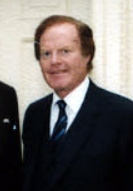Roone Arledge
Roone Pinckney Arledge, Jr. (born July 8, 1931 in Queens , New York City , † December 5, 2002 in New York City) was an American television producer whose broadcast formats had a worldwide influence on the viewing habits of television audiences.
Life
After high school in Wellington , where he was successful in the competition teams in wrestling and baseball , he decided to study sports journalism at Columbia University . To this end, he completed a general bachelor's degree (BA 1952) but then dropped out of his master's degree at the School of International Public Affairs and began working for the DuMont Television Network . He was drafted and did his military service. He then became a producer of children's programs for the local NBC station . Since his pilot project For Men Only did not get a slot on NBC, he offered it to other stations and was hired by the aspiring ABC as a production assistant. He was supposed to be helping broadcast college football. A few months before the first game, Arledge wrote a memo to his producer Edgar J. Scherick , in which he explained his concept: It is not enough to broadcast the game as it is, you have to take the audience with you to the game. For this it is important to also involve the female audience, if necessary to explain the moves of the game in an understandable way for laypeople and to introduce the players as people and to bring them to life. At the age of 29 on September 17, 1960, he was able to implement his concept for the first time in the game Alabama Crimson Tide against the Georgia Bulldogs . Since then, sports broadcasts have changed around the world.
Arledge was then allowed to try out his concept in other sports ( Wide World of Sports ), broadcast athletics, was the producer for all ten broadcasts of the Olympic Games for the USA and gradually became head of sports at ABC in 1968. He invented Monday Night Football , an NFL football game exclusively on Monday night, which was the first time he used 16 television cameras to broadcast it. In his sports programs he told a story each time, so that some of the cameras were also directed at the players who were the story of the story. In 1977 Arledge was also the program director of ABC News, without having experience with news broadcasts with the exception of the Munich massacre. But ABC's news division had poor viewership. He was allowed to experiment, adopted models from sports and finally achieved that from 1986 to 1996 ABC News had the best ratings of all American news programs. In 1998 he gave up his post and in 2002 he died of prostate cancer .
Awards
The Life (magazine) is one Arledge to the 100 Most Important Americans of the 20th Century . For Sports Illustrated , he was number 3 of the 40 people who changed the sport in the past 40 years . In total, Arledge received 37 Emmys for his TV formats . Columbia University named an auditorium after him.
- 1971 NATPE "Man of the Year" Iris Award
- 1990 Television Academy Hall of Fame
- 1997 Walter Cronkite Award for Excellence in Journalism.
- 2001 Pete Rozelle Radio-Television Award from the Pro Football Hall of Fame .
- 2007 Walt Disney Company names Arledge as the Disney Legend
source
- Roone Arledge: Roone: a memoir. New York: HarperCollins, 2003. ISBN 0-06-019733-1
Web links
- Roone Arledge bio at museum.tv
- Roone bio
- Roone Arlege Funeral by Peter Jennings
- ESPN's Page 2 Roone's bio
- Profile page for Roone Artledge at Find A Grave
Individual evidence
- ↑ http://www.filmreference.com/film/91/Roone-Arledge.html
- ^ Benjamin G. Rader: In its own image: how television has transformed sports. New York: The Free Press 1984; ISBN 0-02-925700-X
- ↑ Arnd Krüger & Swantje Scharenberg : How the media prepare the sport - Selected aspects of sports journalism. Berlin: Carpenter, ISBN 3-922654-35-5
- ^ Arizona State University: Walter Cronkite School of Journalism and Mass Communication. Retrieved January 17, 2017 .
- ↑ Disney Legends - Roone Arledge
| personal data | |
|---|---|
| SURNAME | Arledge, Roone |
| ALTERNATIVE NAMES | Arledge, Roone Pinckney junior (full name) |
| BRIEF DESCRIPTION | American journalist, television producer, director of ABC television |
| DATE OF BIRTH | July 8, 1931 |
| PLACE OF BIRTH | Queens , New York City |
| DATE OF DEATH | December 5, 2002 |
| Place of death | New York City |
